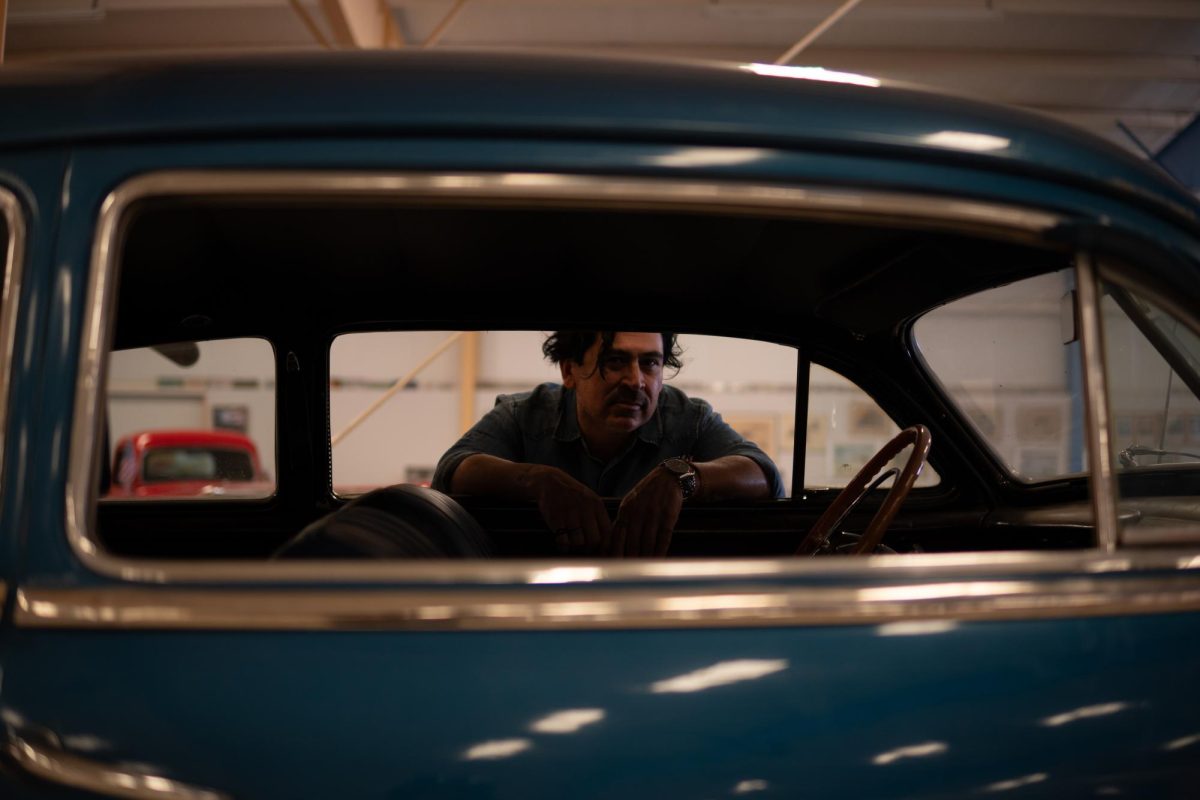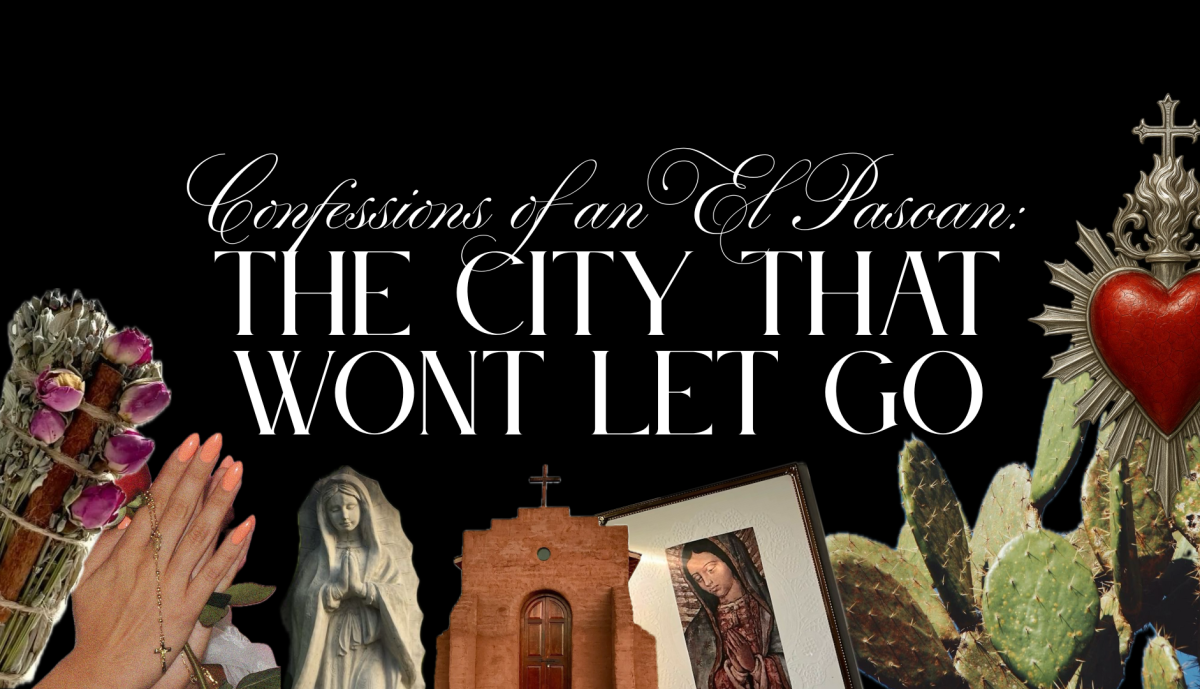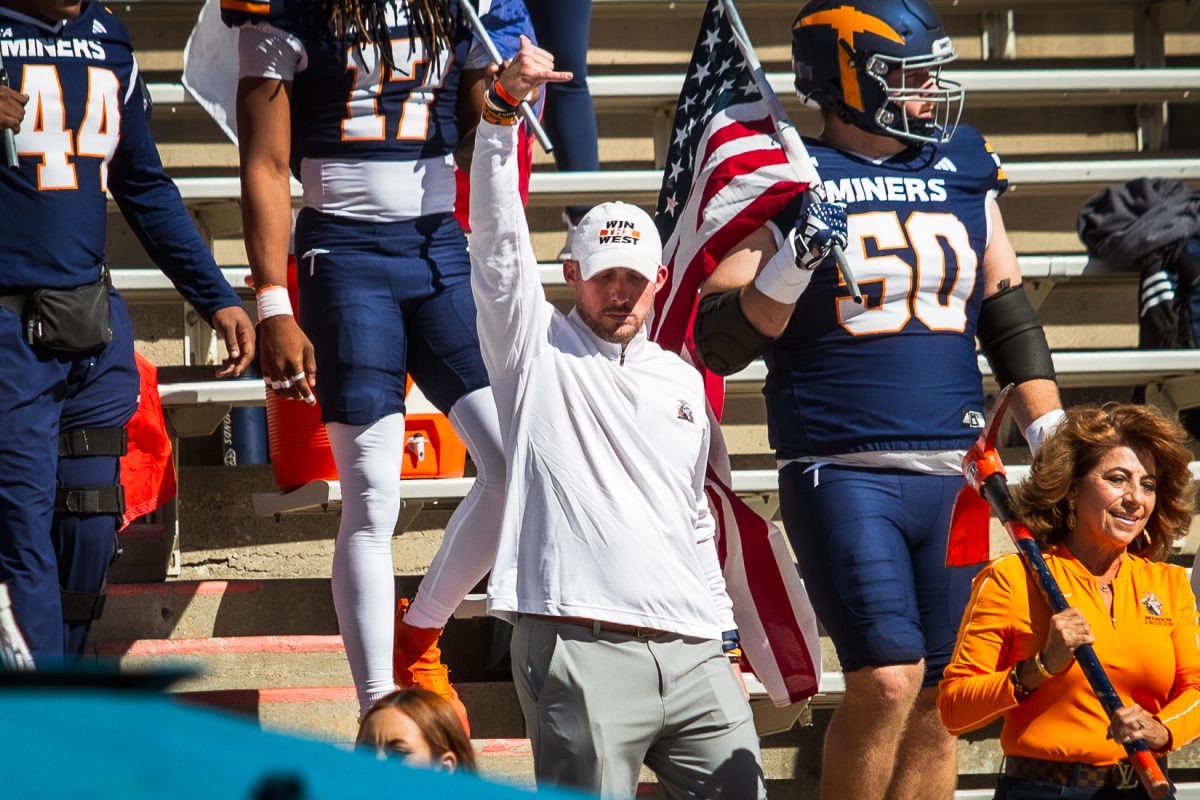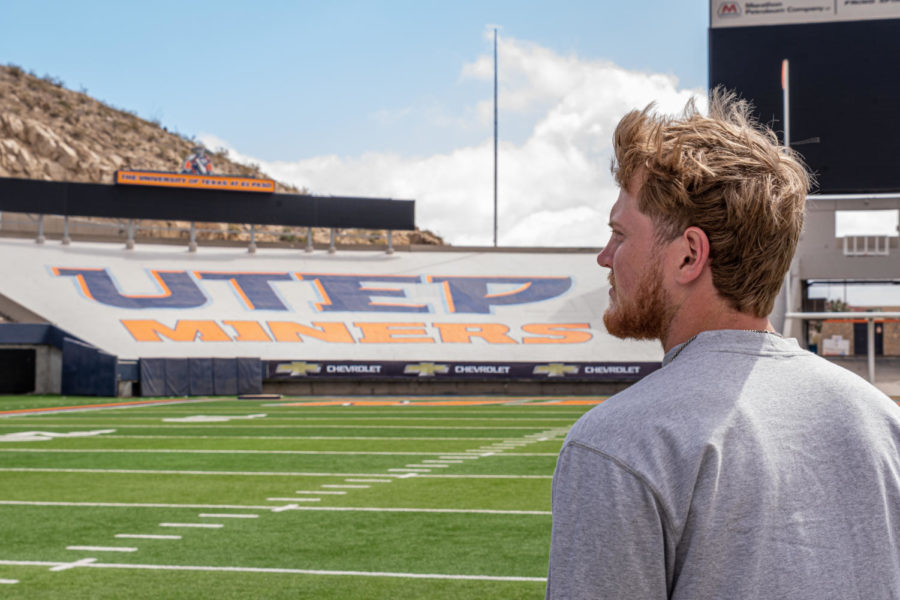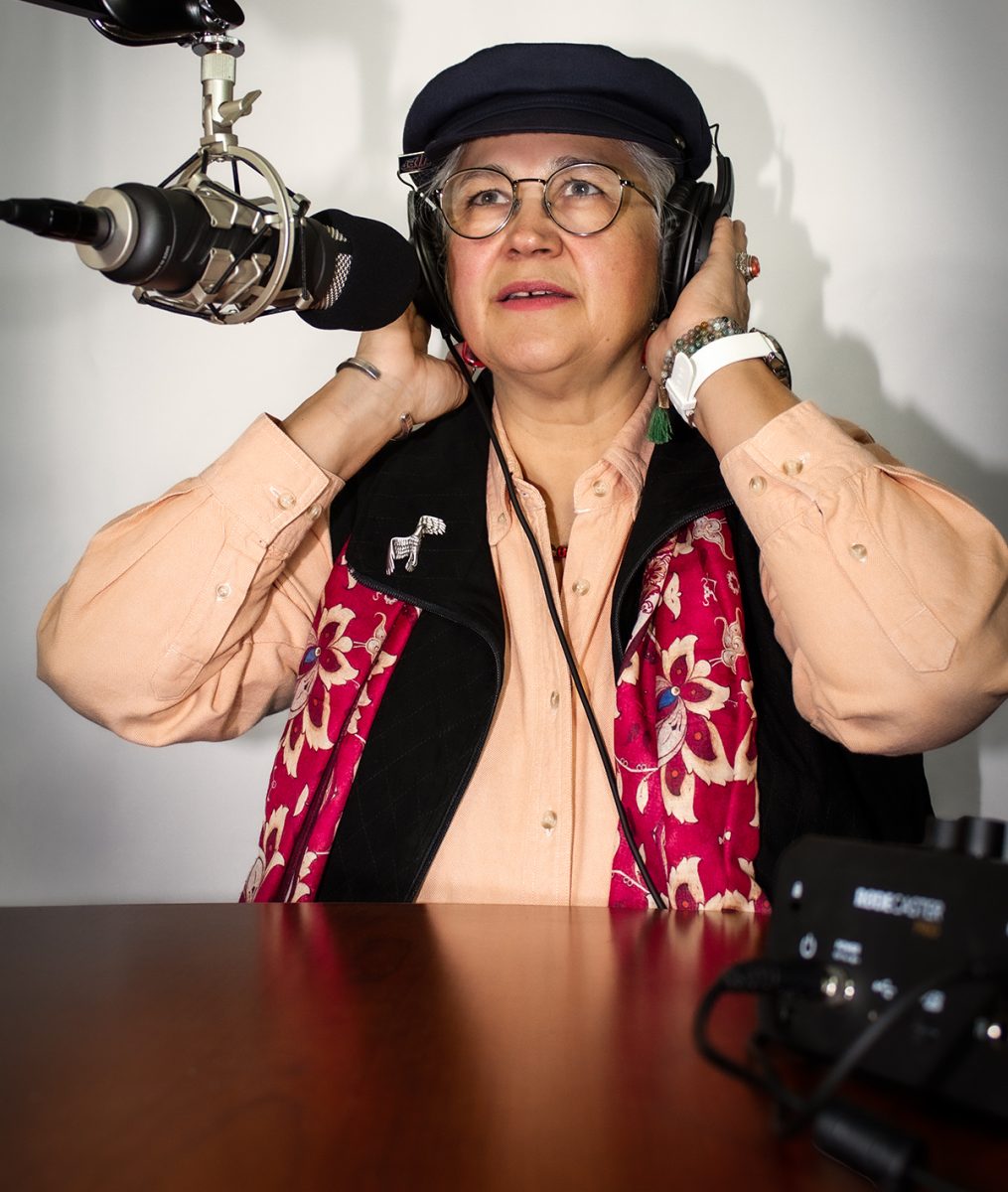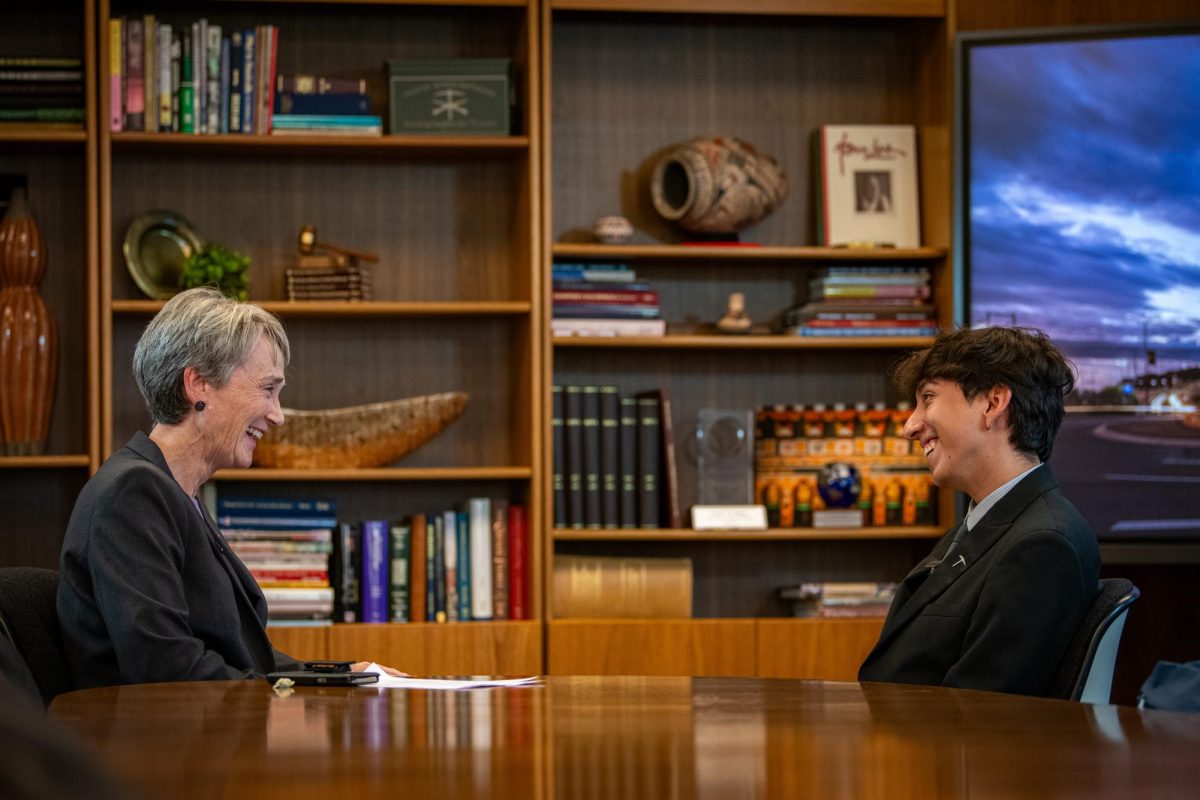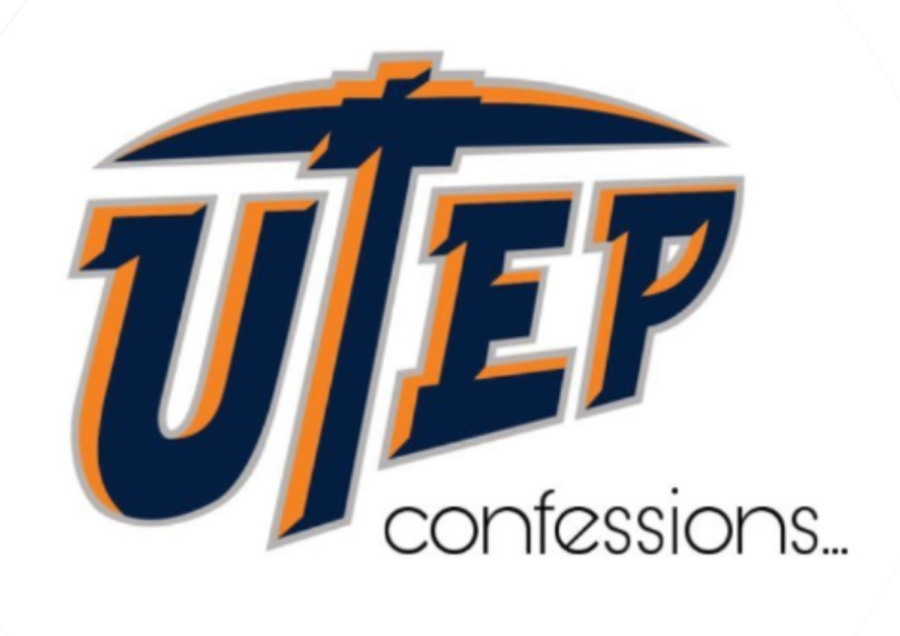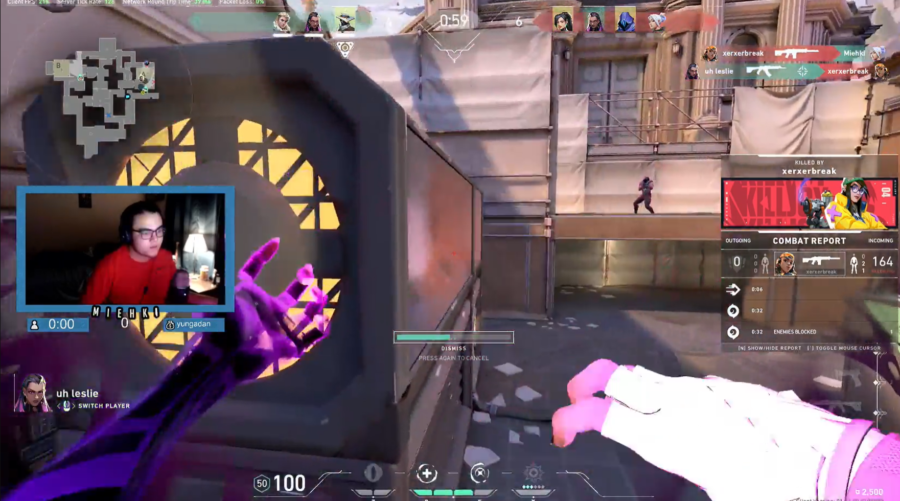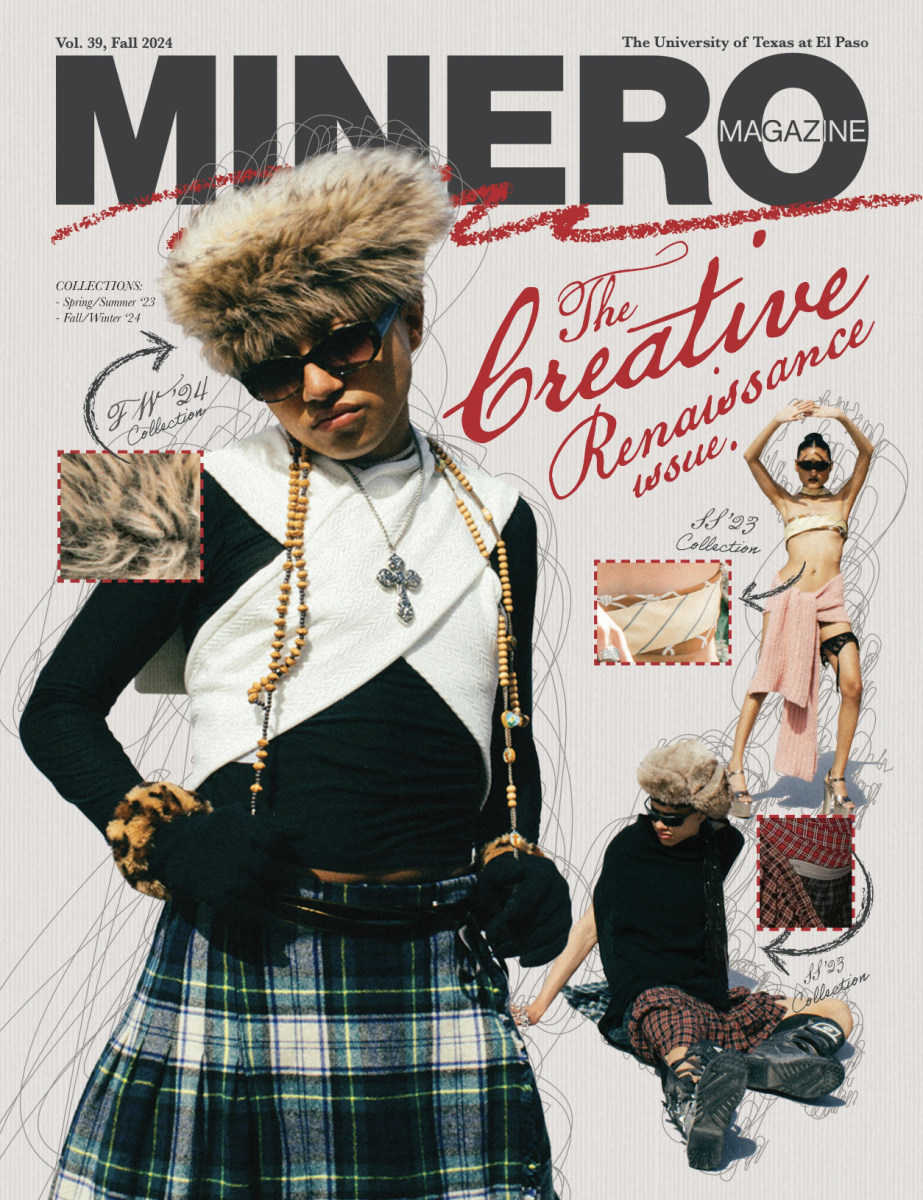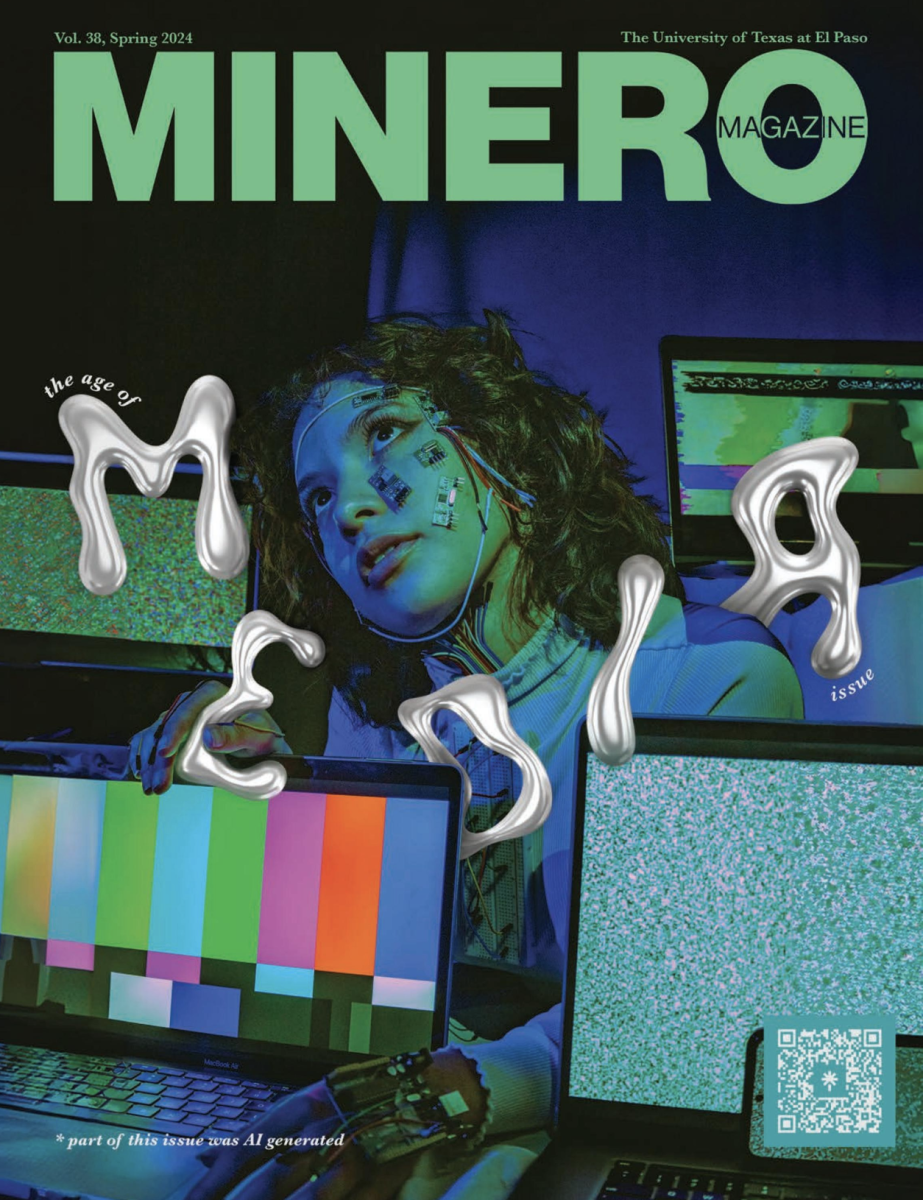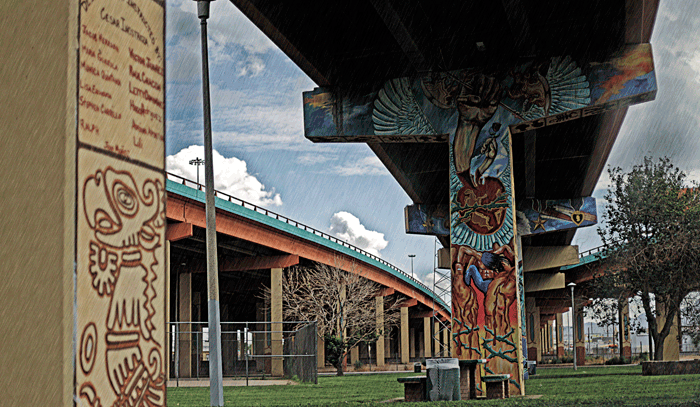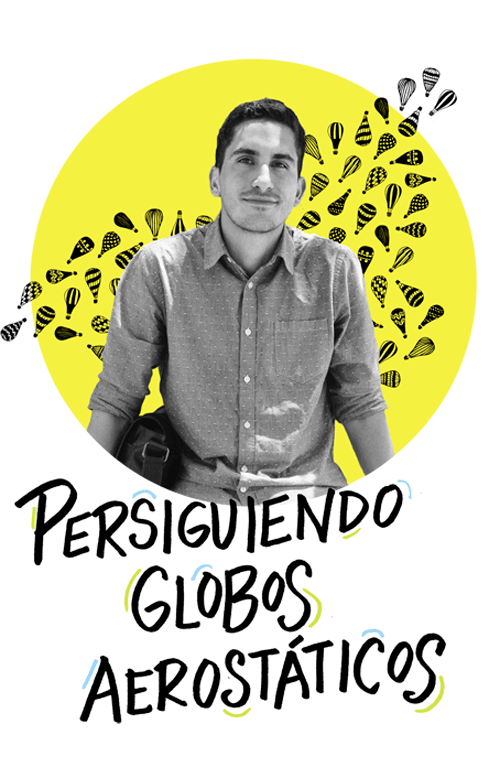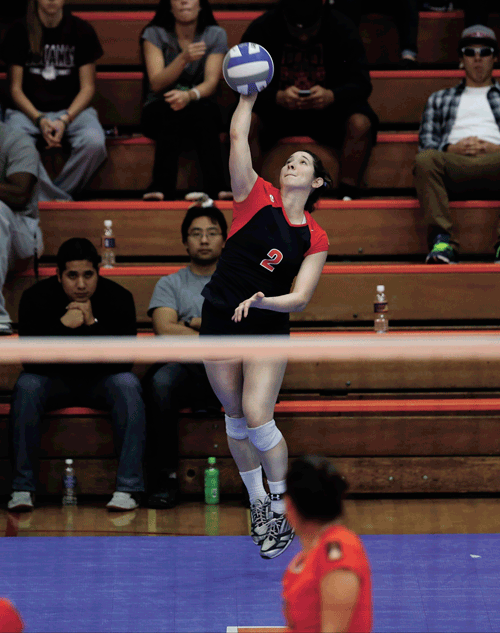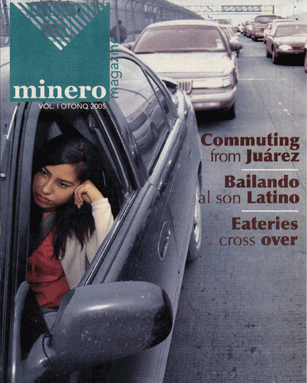
-Protesta estudiantil en UTEP
By: Lorain Watters
Classrooms are empty and the halls are eerily silent on Friday, Dec. 3,1971. Professors stay in their offices as the shouting in the distance grows louder. Outside, the sun beats down on the backs of more than 3,000 students crowded around the Administration Building at UTEP, textbooks and brown handbags in one hand while the other hand forms a fist in the air. Sirens wail off the stucco walls as police officers try to arrest the students. A school bus arrives to escort these students down to the city jail, but a group pops the tires and they begin climbing to the top of the bus, their voices getting louder. Snipers are in the ready position, taking aim from atop the building at the protestors down below, waiting for the signal to begin shooting. Despite this impending danger, students continue to shout, “Viva la raza! Viva la raza!” (Long live the people).
The stirrings for this protest began on March 6, 1970, when students at Roosevelt High School in Los Angeles walked out of their classrooms to protest educational inequalities among Chicanos, a trend that would continue throughout the country, including at the University of Texas at El Paso.
By June 1970, a group of students at the University of California in Santa Barbara drafted the Plan de Santa Barbara, which is considered the manifesto of Chicano studies, and called for equality and representation at the higher education level.
“They made a blueprint and essentially developed how a Chicano studies program would develop at other universities throughout the nation. Students, in particular those involved with Movimiento Estudiantil Chicano de Aztlan, were involved in this model by developing courses and eventually developing the program,” says Dennis Bixler-Marquez, professor and director of the Chicano Studies Program at UTEP. “The university here was very reticent. We started the program in 1970, the same time that UT Austin did, so we both are the oldest Chicano programs.”
Felipe Ortego, a teacher at Jefferson High School, came on board with the movement and was the founding director of the program. “The program was not getting support from the administration, and eventually that led to the takeover of the Administration Building by the students,” Bixler-Marquez says. “Part of it had to do with the fact that this was during the ‘60s and ‘70s—the Vietnam War was happening—and situations like these were happening at other universities. It was a very turbulent period.”
Students were demanding better support for Chicano studies because they felt they were not getting proper representation. “The UT System, under the leadership at that time, was very wary because of La Raza Unida Party, which was seen as a threat coming from the left,” Bixler-Marquez says. “Some of the attorneys and businessmen who supported La Raza were protesting at the front and relaying stories, but no one was paying attention to who was on the roof of the Administration Building. There were snipers, the Texas Rangers, ready to shoot students down. This was happening right after the National Guard shot at the students in Ohio at Kent University. This was very, very real, the violence that accompanied some of these demonstrations and protests, not to mention city riots. They had no problem whatsoever shooting the students when someone gave them the green light.”
Bixler-Marquez was an undergraduate student at UTEP from 1968 1971 and worked as a graduate student between 1971-1973 with the National Teacher Corps. “We didn’t have an educational arm in this kind of movement. This was part of the war on poverty by LBJ (President Lyndon Baines Johnson). Various programs that sought to improve communities in terms of economic development, educational development, social services, better police services, etc., were all based right here in the college of education,” he says.
Before Chicano studies became a program, courses on the subject were offered in other academic departments. If a student wanted to take Chicano history, they had to go through the history department. “We had that situation here. I was director of Chicano studies in ‘78- ‘79. I had gone to school in Stanford and came back. When I came back here, the program was still very much the same—the same bare bones,” Bixler-Marquez says. “There was a secretary, but there was no operational budget to do much, but most of all we didn’t have any courses.”
Before Bixler-Marquez took over the program, then political science professor Roberto Villarreal was in charge and he created the Chicano studies major along with three to four academic minors. However, courses were still missing from the program itself. “There was one course that was being offered when I came, and only offered once in a while. Bixler-Marquez says “We never had the budget to hire someone to teach part time. Now, we offer more than 80 sections from this program,” Bixler-Marquez says.
As the program grew, so did the number of Chicanos being hired to teach the classes, and eventually, a more diverse pool of individuals were becoming involved with the program.
“You can take a course in Chicano studies in English from an Austrian professor—which shows you how much the discipline has grown worldwide, but it is just as important that we have in the same department a Chicano teaching Shakespeare. I consider that a tremendous level of development,” Bixler- Marquez says. “Not all departments can be like that, but it has helped in some degree that we have also gotten people who are not Chicano, Latino or Mexican, who are interested in the discipline and have been hired—like doing Chicano art. We don’t want the doors closed.”

The program currently offers 22 sections of Chicano studies courses online, which were developed within the past two years. Eventually, the program will offer a Chicano studies major online. “Now, many of our graduates are in key positions—attorneys and judges. We have student organizations like the Chicano Pre- Law Society to help students into law school,” Bixler-Marquez says.
The Chicano Pre-Law Society was formed to cater to a specific group of individuals entering law school, who were not being represented in the work force. “These groups were to get people educated, take the right courses that would get them into law school, medical school, etc. We also have the Mexican Civil Engineering Society—they recruit at high schools and make sure that those who want to be engineers look like the recruiters,” Bixler- Marquez says.
For Bixler-Marquez, the engineering college has been responsive and was a key group during the Chicano rights movement. “We wanted to open doors that were not open before. Many of them were not open because of the quality of education that was being offered at the public schools, the counseling that was done late in students’ high school years,” he says.
This initiated the formation of a tutorial center on campus. “We recognized the problem, and eventually the state voted to allocate funds and acknowledge that students needed these tutorial sources. It wasn’t until the mid ‘70s that we had a community college,” he says.
Ricardo Cortez graduated from UTEP in 2009 with a double major in Chicano studies and political science. “I wanted to learn more about my culture, that was the foundation. I wanted to learn about who I am,” Cortez says. “We grow up in El Paso and it seems homogenous. The concept of being Mexican-American, Latino or Chicano is based on living the music and food, that is the extent of their knowledge of being Mexican. I wanted to learn more about it besides everyday life.”
Being interested in the history of his people and becoming familiar with ideologies and the philosophies with other countries led Cortez to pursue his double major. “When I graduated there were only two other people who were also political science and Chicano studies majors. It’s not your traditional type of study,” Cortez says.
After graduating from law school in 2013, Cortez took the bar exam in February and received his results in May, allowing him to begin the process of applying to law offices. “My girlfriend was already a practicing attorney when we met in law school. So while we were dating, she got a job in New York and invited me to come with her. I moved up here because of her and the work she was already doing.
Eventually I sent my resume to an office in New Jersey and they called me back within two days,” Cortez says.Watch movie online The Transporter Refueled (2015)
As Cortez has progressed in his legal career, he has encountered instances where his Chicano studies degree plays a part. “There was a case, where the person’s defense attorney did not inform him of the collateral consequences while pleading guilty, especially in relation to his immigration status,” Cortez says. When the individual wanted to apply for citizenship or receive the equal rights of a citizen in the United States, he was denied because he had pled guilty. “Everything is tied together in the sense of how Chicanos have affected the landscapes of the law or how it has affected us because of the particular circumstances they are in,” Cortez says.
The Chicano Studies Program has two major events in public programming—the Hispanic Heritage Celebration, which begins in September, that works with other departments on campus to provide events and opportunities for students to see Hispanics who are successful in the variety of departments, and the Cesar Chavez celebration that takes place every spring. One of the dimensions of the Chicano Studies Program is civic engagement. Students are encouraged to give back to the community and that, in whatever they may do, they are meeting the needs in the community. “We work with the local farmers and do fundraisers like the sock drives. Of course, we accept canned goods, but the reason we do the sock drives is because that is the one thing farmers ask for. When you’re out in the field, you want clean socks,” Bixler-Marquez says.
Bixler-Marquez says UTEP’s Chicano Studies Program is at the forefront of the nation, and offers research fellow programs, where social scientists come from other countries to study.
The Chicano Studies Program has welcomed scholars from El Colegio de la Frontera Norte (Tijuana, Mexico) and the Instituto Nacional de Antropología e Historia in Mexico City, universities in Slovakia, Hungary and Cuba, as well as Dr. Sang-Rae Lim from the University of Pusan in South Korea, who just published a book about Chicano studies in Korean for the program there. “Now, word has gone around that we are the place to do this—they don’t go to UT Austin or San Antonio to learn about Chicano studies. There was a high school in L.A. that approached us to help them with their program,” Bixler Marquez says. “It is a big dimension that no other Chicano studies program has in the country.”
The Chicano Studies Program has also established The Mexico Research Network, which funds faculty from both the U.S. and Mexico. “If someone from here needed to go to Puebla, Mexico, to do research or have someone from there come here and do research at our library, such as on the Bracero program, they can,” Bixler-Marquez says. “They will receive grants for the various projects that they set out to do.”
The Bracero program began in the 1940s to bring in manual laborers from Mexico to address labor shortages that were happening in the U.S. due to World War II. “We found the files in a small town in Mexico, digitized everything and now both universities, here and in Ciudad Juárez, have access to those files. Many come and do research because their families were a part of that experience,” Bixler- Marquez says.
The Chicano Studies Program at UTEP now functions like that of the UT Austin’s Center for Mexican-American Studies or the UCLA Chicano Studies Research Center because of the research components. “We have a research working group, or a permanent seminar as they call it in Mexico. Experts or people who have the same area interests will come together and function like a professional organization by holding meetings. We have universities in Mexico and across Texas who will send representatives here to meet with us, but that has changed recently because of restrictions, so we meet by Skype now,” Bixler-Marquez says.
The research working group began when an increased number of women were being killed or disappearing in Juárez. These scholars came to the university to find out what type of research was needed. “We offered the first certificates for faculty on both sides of the border so they could take that information, make the courses and be prepared on that subject matter when offering the class at the university,” Bixler-Marquez says. “Right now we have published eight books, a journal and have produced three documentaries, which has exceeded any other department on campus.” One such documentary was “Señorita Extraviada,” a 10-year follow-up on the violence in Mexico, led to another documentary on a family, whose daughter was killed and they had to flee Cd. Juárez because of the violence and the imminent threat that they were facing. “So this group deals with violence, gender and culture on the border. We look at both sides. Right now, we have a team of people who are doing research on the people who have fled northern Mexico because of the violence and seeing how they have adapted since,” Bixler-Marquez says. “Some might have post-traumatic stress disorder. One of the staff members here is actually a refugee of the violence.”
The program currently has 30 academic majors and minors with the end goal of getting academic departmental status. “We have already asked for permission from the administration. We need money to hire full-time faculty and that can build on making a master’s program,” Bixler-Marquez says. “It’s time for us to move in that direction, we should be leading not following Pan Am, San Antonio or Austin. If we can’t do that, what’s the sense of talking about our demographic?”
Laura Bolanos, academic advisor for the College of Liberal Arts, graduated from UTEP in 2008 with a double major in Chicano studies and history. She is now working on her doctoral degree in educational administration. “The main reason I got into Chicano studies was because my own parents were born here in the states and they were teenagers in the ‘50s. They would go outside to play tetherball in the corner or kickball in the street, and they were chastised by immigration every day,” Bolanos says. “They made it a point that whenever they did have children that they were going to assimilate us as much as they could and immerse us into this Americanized way of bringing up your kids.”
Bolanos’ parents did not want their children to suffer, which led to the lack of education about their ethnic background. “I chose Chicano studies so I could learn about those missing pieces. When I came to UTEP, I made it a major and I was able to fill in the blanks. It was something that I couldn’t learn about in school because it wasn’t there. We learned everyone else’s history, but we weren’t represented in that area,” Bolanos says. “At the university level, I started to learn some amazing things that I couldn’t learn growing up because it wasn’t taught. My family was very Americanized—we went on family vacations, spoke English at home and my Spanish to this day is still pretty bad.”
Bolanos acknowledges that people fought hard to change the belief system on campus. By doing so, Chicanos as a whole made a difference in the country. “It was a way to be proud to be an American without sacrificing identity. I want to teach my kids that too, because it seems like with every generation something is lost and now I am able to teach them what I was barely learning,” she says.
Bolanos also volunteers during her time at UTEP, working with people in the colonias (undeveloped settlements) and Los Comadres de Las Americas, (an organization that promotes connections between Latinas). “I was able help a lot of people who weren’t doing well by collecting things, like household items, for them. I think it’s important to continue to do my part. I think that students are successful when they see themselves in those who are teaching them,” Bolanos says. “We have to raise ourselves up and through education we can do that. We are the largest growing minority and out of that group, the biggest demographic are Mexican-Americans. So we have to do more because we are going to define the future and if we’re not educated it’s going to be hard to do.”
As an advisor, Bolanos says she can mentor students with any problems they may encounter, some of those being cultural. “Some students have parents who are very old school. They don’t see the value in education or in a degree. To them, they want their children to find a good job, get married to a good wife—there is still backward thinking,” she says. “My goal is to inspire as many students as possible to go forth and prosper. Here in El Paso, it is a bit different since we are primarily Hispanic. We don’t see things that other people might see in other parts of the country, but at the same time, there are a lot of needs that this particular demographic requires.”
Bolanos says she believes that the program should continue to grow with an addition of newer courses on diverse topics. “There’s nothing wrong with being a part of the dominant culture, so to speak, but you should never forget your roots or where you came from because we all came from somewhere,” she says. “We lose that all the time, but these courses help to remind people to be mindful that we are part of this country and we did a lot to further its growth and we’re going to continue on.”





